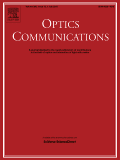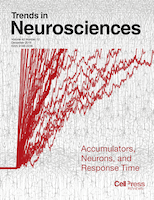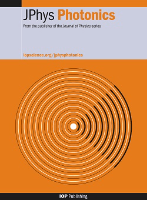
Neurophotonics
Scope & Guideline
Harnessing Light to Illuminate the Mind
Introduction
Aims and Scopes
- Optical Imaging Techniques:
Neurophotonics emphasizes the development and application of advanced optical imaging techniques, such as two-photon microscopy, fiber photometry, and holographic endoscopy, to visualize and understand neuronal activity and brain structures. - Neuroimaging Applications:
The journal covers a wide array of neuroimaging applications, focusing on methods that allow researchers to study brain function in vivo, including functional near-infrared spectroscopy (fNIRS) and photoacoustic imaging. - Neurotechnology Innovations:
Neurophotonics explores innovative neurotechnologies, such as implantable photonic devices and optogenetic tools, aimed at enabling targeted modulation of neural circuits and enhancing the precision of neural signal recordings. - Multimodal Approaches:
The integration of various imaging modalities and techniques is a core focus, highlighting research that combines optical methods with electrophysiology, MRI, and computational modeling to provide comprehensive insights into brain function. - Neural Dynamics and Mechanisms:
The journal aims to elucidate the underlying mechanisms of neural dynamics, including synaptic plasticity, hemodynamics, and neurovascular coupling, using advanced optical methods to study these processes in real-time.
Trending and Emerging
- Advanced Optical Probes:
There is a significant trend toward the development of advanced optical probes, such as implantable photonic devices and nanoscale modulators, which enhance the ability to interface with and manipulate neural circuits in real-time. - Computational Approaches in Imaging:
The integration of computational techniques, including machine learning and data analytics, is increasingly prominent in neurophotonics research, aiding in the analysis of complex imaging data and improving the accuracy of neuroimaging methods. - Real-time Monitoring of Neural Activity:
Emerging research focuses on real-time monitoring of neural activity using high-speed imaging techniques, enabling the study of dynamic neural processes and interactions during behavior and cognition. - Neurovascular Coupling Studies:
There is a growing interest in understanding neurovascular coupling, with studies utilizing advanced optical techniques to investigate the interplay between neural activity and vascular responses, which is crucial for understanding brain health and disease. - Application of Bioluminescence and Optogenetics:
The use of bioluminescence and optogenetic tools is on the rise, as researchers explore their potential for precise control of neuronal activity and for studying complex neural networks in vivo.
Declining or Waning
- Traditional Imaging Modalities:
There is a noticeable decline in the focus on traditional imaging modalities such as standard fluorescence microscopy, as researchers increasingly favor advanced techniques that offer higher resolution and deeper tissue penetration. - Basic Neuroscience without Optical Techniques:
Research solely based on basic neuroscience principles without the application of optical techniques is waning, as the field moves toward more integrative approaches that utilize light-based methodologies for deeper insights. - Invasive Methods in Neuroimaging:
The use of highly invasive methods for neuroimaging is becoming less common, with a growing preference for minimally invasive or non-invasive techniques that reduce risks and improve accessibility for human studies.
Similar Journals

Biomedical Optics Express
Advancing Knowledge Through Optical TechnologiesBiomedical Optics Express, published by the prestigious Optica Publishing Group, is an open-access journal that has been at the forefront of the field of biomedical optics since its inception in 2011. With an ISSN of 2156-7085, this journal has established itself as a premier platform for disseminating high-quality research that spans an array of topics in atomic and molecular physics, optics, and biotechnology. As a testament to its scholarly impact, it is currently ranked in the Q1 category for both Atomic and Molecular Physics and Biotechnology, reflecting its commitment to excellence within these disciplines. The journal features cutting-edge articles that foster innovation and collaboration among researchers, professionals, and students who are passionate about applying optical technologies to solve pressing challenges in medicine and biology. Based in the United States, Biomedical Optics Express continues to shape the future of optical science and its applications, inviting contributions that inspire and drive forward the boundaries of knowledge.

Optics
Unveiling the Wonders of Light and Its ApplicationsOptics is a pioneering open access journal published by MDPI, dedicated to advancing the field of optics and photonics. Since its inception in 2020, the journal has fostered the dissemination of high-quality research and innovative developments in optical sciences, contributing significantly to its community of researchers, professionals, and students in Switzerland and beyond. With an impact factor reflective of its growing prominence, Optics strives to address a diverse scope, encompassing atomic and molecular physics, electronic materials, and broader topics in physics and astronomy. The journal's commitment to open access ensures that cutting-edge research is freely available, promoting collaboration and knowledge-sharing across disciplines. As of 2023, it holds a Q4 ranking in several categories, including Atomic and Molecular Physics, and Optics, which illustrates its evolving role in the academic landscape, positioning it as a valuable resource for those seeking to explore the frontiers of optical technology and its applications.

NEUROPHYSIOLOGY
Pioneering Discoveries in Neuroscience and PhysiologyNEUROPHYSIOLOGY, published by SPRINGER, is a distinguished journal dedicated to advancing the understanding of neural function and physiological processes across a broad spectrum of topics. With a rich history dating back to 1969, this journal has been instrumental in disseminating pivotal research findings and theoretical advancements within the fields of neuroscience and physiology. Although it currently ranks in the fourth quartile of both the Neuroscience (miscellaneous) and Physiology categories, this journal remains a valuable resource for researchers and professionals seeking to explore innovative methodologies and address critical issues within neurophysiological studies. While NEUROPHYSIOLOGY does not offer open access options, its latest research continues to provide insights and stimulate discussions essential for education and ongoing inquiry. Publishers and contributors to this journal contribute to a growing repository of knowledge right from the heart of the United States.

Chinese Optics Letters
Transforming knowledge into optical advancements.Chinese Optics Letters is a prestigious academic journal published by Chinese Laser Press, dedicated to advancing the fields of atomic and molecular physics, optics, as well as electrical and electronic engineering. Since its inception in 2003, this journal has become a significant platform for researchers and professionals to disseminate innovative findings and foster collaboration within these rapidly evolving disciplines. With a commendable Q2 ranking in leading categories including Atomic and Molecular Physics and Electronic, Optical and Magnetic Materials, it ranks favorably within the Scopus database, with notable positions in both engineering and materials science sectors. The journal is headquartered in Shanghai, China, and while additional open access options are not specified, it remains a vital resource for those committed to pushing the frontiers of optical research and applications. As we approach 2024, Chinese Optics Letters continues to play an essential role in shaping scholarly discourse and technological advancement in optics.

OPTICS COMMUNICATIONS
Bridging Science and Application in PhotonicsOptics Communications, published by Elsevier, is a prestigious international journal that focuses on the dynamically evolving fields of optics and photonics. With its ISSN 0030-4018 and E-ISSN 1873-0310, this journal has made significant contributions to the fields of Atomic and Molecular Physics, Electrical and Electronic Engineering, Electronic, Optical and Magnetic Materials, and Physical and Theoretical Chemistry, consistently ranking in the Q2 quartile across these categories for 2023. The journal, based in the Netherlands, is recognized for its rigorous peer-review process and aims to publish high-quality research articles that advance knowledge and applications in optical communication technologies. Although it operates under a subscription model, the insightful research published here plays an essential role in informing the work of researchers, professionals, and students alike. With a history dating back to 1969 and spanning well into 2025, Optics Communications remains a crucial resource for cutting-edge developments in optics, catering to a global audience dedicated to innovation in this pivotal science.

TRENDS IN NEUROSCIENCES
Exploring the Frontiers of Brain ResearchTRENDS IN NEUROSCIENCES, published by CELL PRESS, is a leading journal in the field of neuroscience, offering cutting-edge insights and important developments in the rapidly evolving landscape of brain research. With an impressive Impact Factor and ranking in the top quartile (Q1) of the category for Neuroscience (miscellaneous), it is positioned as a vital resource for researchers and professionals seeking to stay abreast of the latest discoveries and trends from 1978 to the present. Specifically ranked #3 out of 113 in General Neuroscience by Scopus, this journal promotes the interdisciplinary exchange of ideas and knowledge, making it an essential platform for students and experienced scholars alike. Although it is not an Open Access journal, its value lies in its rigorous peer-review process and commitment to maintaining the highest standards of academic integrity. By continuing to explore the complexities of neural processes and behavior, TRENDS IN NEUROSCIENCES plays a crucial role in shaping the future of neuroscience research and education.

Journal of Physics-Photonics
Advancing Knowledge in Light and MatterJournal of Physics-Photonics, published by IOP Publishing Ltd in the United Kingdom, is an esteemed Open Access journal that has been at the forefront of research in the field of photonics since its inception in 2018. With an impressive portfolio, the journal has achieved Q1 ranking in 2023 across multiple disciplines, including Atomic and Molecular Physics, Electrical and Electronic Engineering, and Electronic, Optical, and Magnetic Materials. This positions it among the leading journals in these areas, reflecting its significant influence and contribution to advancing knowledge and innovation. The journal aims to disseminate high-quality research findings that encompass a wide range of topics in photonics, promoting interdisciplinary approach that fosters collaboration among researchers, professionals, and students. With its commitment to open access, Journal of Physics-Photonics ensures that groundbreaking research is accessible to all, empowering a global audience to engage with and benefit from the latest advancements in photonic technologies.

NEUROIMAGE
Pioneering Insights into Brain Structure and FunctionNEUROIMAGE, published by Academic Press Inc Elsevier Science, is a leading international journal dedicated to advancing the fields of cognitive neuroscience and neurology. With an impressive impact factor that places it in the Q1 category for both disciplines, NEUROIMAGE stands at the forefront of disseminating high-quality research that employs advanced imaging methods to elucidate the workings of the human brain. As a pivotal platform since its inception in 1992, this journal has continued to thrive, embracing Open Access publishing since 2020 to ensure wider dissemination and accessibility of cutting-edge findings. With a Scopus rank of 7th in cognitive neuroscience and 13th in neurology, and situated in the 94th and 93rd percentiles respectively, NEUROIMAGE serves as an invaluable resource for researchers, professionals, and students alike seeking to explore the intricate relationships between brain structure and function. For more information, please visit their office at 525 B ST, STE 1900, SAN DIEGO, CA 92101-4495.

JOURNAL OF OPTICAL TECHNOLOGY
Transforming Knowledge into Optical SolutionsJOURNAL OF OPTICAL TECHNOLOGY, published by the Optica Publishing Group, serves as a vital resource for researchers and professionals in the fields of optical technology and related disciplines. Established with a commitment to advancing knowledge, this journal spans a broad spectrum of topics, including applied mathematics, atomic and molecular physics, and various engineering disciplines, with a converged publication period from 1995 to 2024. Although it currently holds a Q4 ranking across multiple categories in 2023, it is an important platform for innovative research ideas in a rapidly evolving field. The absence of Open Access may guide readers to explore alternative access options through institutional subscriptions. The journal’s ISSN is 1070-9762 and its E-ISSN is 1091-0786, ensuring accessibility for a global audience. As a publication aimed at fostering scholarly communication, it invites contributions that highlight emerging trends and novel developments in optical technology, catering to a multifaceted audience of researchers, professionals, and students.

Neuroscience Bulletin
Illuminating the complexities of brain science.Neuroscience Bulletin is a prestigious academic journal published by SPRINGER, focusing on the dynamic and interdisciplinary field of neuroscience. Established in 2005, this journal has consistently provided a platform for groundbreaking research, showcasing contributions that span various aspects of neuroscience, physiology, and medicine. With an admirable impact factor and recognition as a Q1 journal in both Medicine and Neuroscience categories for 2023, it ranks highly in the Scopus metrics, reflecting its importance in advancing scientific knowledge and practice. Researchers and professionals alike benefit from its cutting-edge articles, which are accessible through traditional subscription models. The Neuroscience Bulletin plays a crucial role in disseminating significant findings and fostering collaboration within the global research community, making it an essential resource for anyone engaged in the exploration of neural mechanisms, treatments, and innovations.